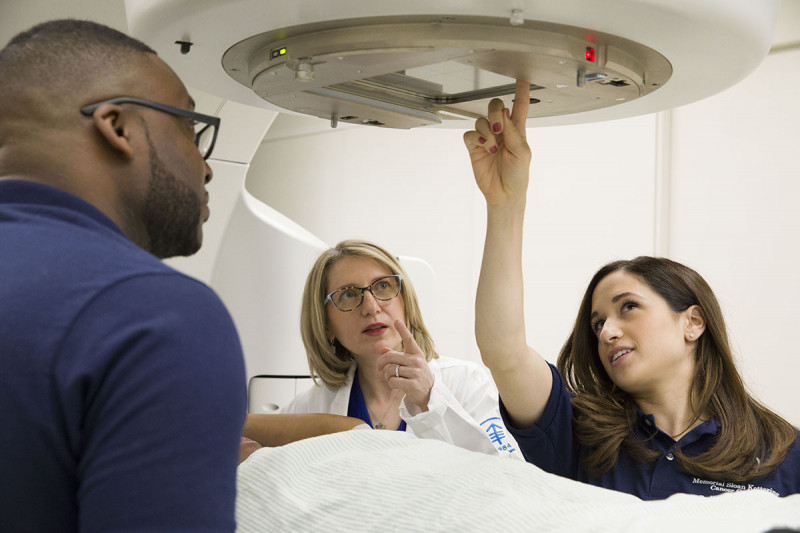
Human papillomavirus (HPV)–associated oropharyngeal cancer is on the rise, but at Memorial Sloan Kettering Cancer Center, we have updated our standard of care to substantially reduce the radiation dose to elective regions.
In our paper, published recently in the journal Practical Radiation Oncology, we summarize our current standard dose prescriptions and explain the rationale for our choices. Our recommendations are based on the American Joint Committee on Cancer Seventh Edition tumor-node-metastasis staging system. Note that these recommendations apply only to patients who receive concurrent platinum-based chemotherapy and who test positive in both p16 immunohistochemistry and HPV RNA in situ hybridization tests.
Over the years, given our excellent treatment outcomes, we have eliminated radiation in regions of the head and neck that are not at risk for disease spread but used to be included in our treatment fields. We omit level IV in the node-negative neck, given retrospective data that suggest the involvement of level IV is rare in this instance, and we rely on thorough staging using PET, CT, and MR imaging followed by confirmatory fine-needle aspiration of any suspicious lymph nodes. We also omit the retropharyngeal and high-level II nodal basins in the node-negative neck, which does not appreciably increase the risk of recurrence in this area. (1) Patients with well-lateralized T1-T2 palatine tonsillar cancer, without soft palate or base of tongue involvement, with N0-N1 disease do well with unilateral radiation to cervical nodes. (2), (3)
Recommended Dose Reductions for Select Patients
Many radiation oncologists have decreased the radiation dose for patients enrolled in clinical trials to target areas in select HPV-associated cancers given data on their biology and radiosensitivity.
At MSK, we conducted a pilot study using intratreatment PET imaging response with a hypoxia tracer to select patients to test an even more dramatic radiation dose reduction. In the initial study of 33 patients with HPV-positive oropharyngeal cancer who had a resolution of the tracer and received reduced radiation to 60 grays (Gy), 100 percent achieved two-year locoregional control. (4) Next, we lowered the dose further to 30 Gy for 19 patients based on intratreatment imaging for hypoxia. Primary tumors were removed surgically, followed by radiation treatment to 30 Gy, at 2 Gy per fraction to gross nodal disease and elective volumes, given concurrently with two cycles of cisplatin. At four months, patients underwent neck dissection for pathological confirmation that 30 Gy had eliminated gross disease. A total of 11 of 14 patients had a complete pathologic response, and three had a partial pathological response. After at least three years of follow-up, all 14 patients treated as per the protocol had achieved locoregional control. (5)
Based on the promising results with selecting hypoxia-negative patients to undergo a reduced dose to 30 Gy as noted in our pilot study above, we are currently conducting a phase II clinical trial in which neck dissection has been omitted from the treatment protocol. The rationale for 30 Gy springs from historical data from Nigro’s classic paper, which reported the possibility of eradicating HPV-related gross tumors in patients with anal squamous cell carcinoma. A majority who were treated with preoperative chemoradiation to 30 Gy with concurrent 5-fluorouracil and mitomycin C achieved a complete clinical or pathological response. (5)
The Rationale for Lower-Dose Radiation to Microscopic Regions
Based on historical data and recent trials specific to HPV-positive oropharyngeal carcinoma, we have reduced the radiation dose to elective regions, as is our current standard practice. We still treat gross visible disease to 70 Gy. However, we have lowered the radiation dose to 30 Gy for most elective regions. (6) This lower dose is only considered for patients who receive platinum-based regimens, preferably concomitant high-dose cisplatin at 100 mg/m2 every three weeks. We do not de-escalate the dose in elective regions in patients who receive radiation alone or nonplatinum-based regimens, such as cetuximab. (1)
There are only two dose levels we employ: 30 Gy (15 fractions of 2 Gy) to elective regions, followed by a cone down of 40 Gy, for a total of 70 Gy to all gross disease sites. We use PET/CT with contrast and MR or CT with contrast to delineate primary disease. The planning target volume (PTV) margins of elective regions are two to three millimeters (mm). (1)
For gross tumor volume (GTV) receiving 70 Gy, we expand via anatomic routes of spread, typically around five mm margins to PTV70, instead of expanding concentrically. We do not add a 70 Gy target volume around the GTV70. Note that we also use a standard 2 Gy per fraction to the GTV as preferable over accelerated fractionation to minimize late complications. (1)
We feel that this microscopic dose is sufficient for these patients. A pooled series of trials of both HPV-positive and HPV-negative oropharyngeal cancers found that elective nodal volumes of 40 Gy did not result in any failures within the elective targets in the HPV-positive cohort. (7) Further, another study recently published results for extreme dose reduction: Among 82 HPV-positive postoperative patients, doses of only 30 to 36 Gy successfully eradicated microscopic disease, with a two-year locoregional control of 95 percent. (8)
Advancing HPV-Associated Oropharyngeal Cancer Care
At MSK, we are dedicated to ensuring that our patients receive the right doses to achieve the best outcomes possible while minimizing the toxic effects of treatment. Fewer than 8 percent of our patients are treated with trimodality therapy, which includes concurrent chemoradiation, robotic surgery with postoperative radiation or chemoradiation, and induction chemotherapy followed by chemoradiation. This is significantly lower than the North American average of 41 percent. (9)
This study was funded in part by a National Institutes of Health/National Cancer Institute Cancer Center Support Grant (P30 CA008748–50).
The study authors declare no conflicts of interest.

